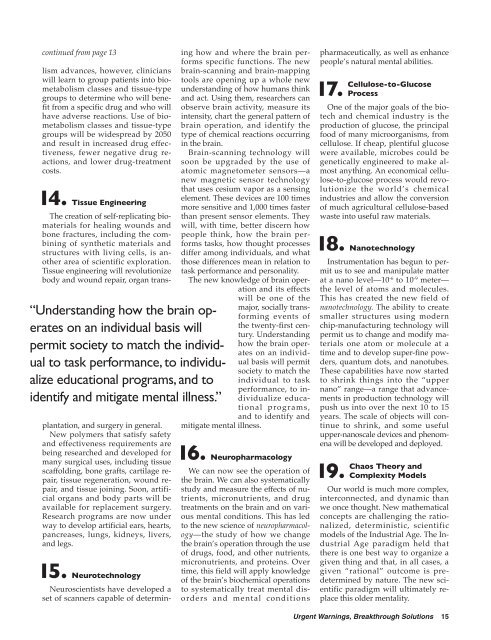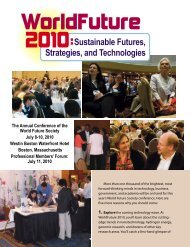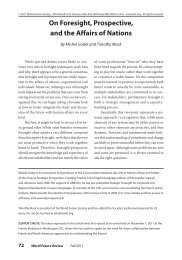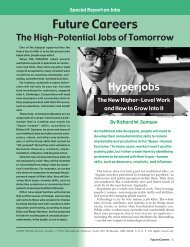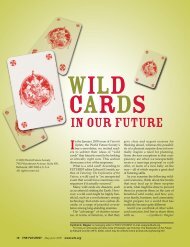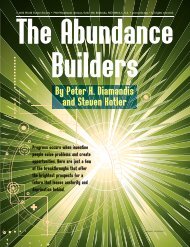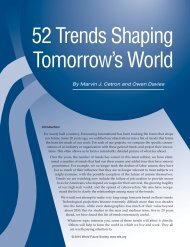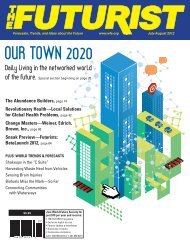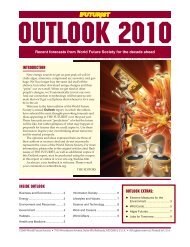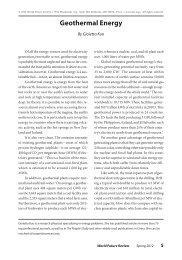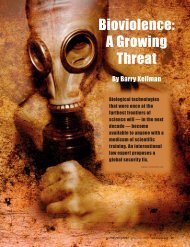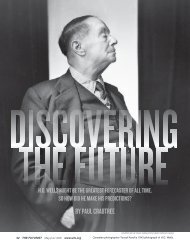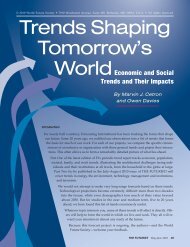Urgent Warnings, Breakthrough Solutions, Second Edition
Urgent Warnings, Breakthrough Solutions, Second Edition
Urgent Warnings, Breakthrough Solutions, Second Edition
You also want an ePaper? Increase the reach of your titles
YUMPU automatically turns print PDFs into web optimized ePapers that Google loves.
continued from page 13<br />
lism advances, however, clinicians<br />
will learn to group patients into biometabolism<br />
classes and tissue-type<br />
groups to determine who will benefit<br />
from a specific drug and who will<br />
have adverse reactions. Use of biometabolism<br />
classes and tissue-type<br />
groups will be widespread by 2050<br />
and result in increased drug effectiveness,<br />
fewer negative drug reactions,<br />
and lower drug-treatment<br />
costs.<br />
“Understanding how the brain operates<br />
on an individual basis will<br />
permit society to match the individual<br />
to task performance, to individualize<br />
educational programs, and to<br />
identify and mitigate mental illness.”<br />
14. Tissue Engineering<br />
The creation of self-replicating biomaterials<br />
for healing wounds and<br />
bone fractures, including the combining<br />
of synthetic materials and<br />
structures with living cells, is another<br />
area of scientific exploration.<br />
Tissue engineering will revolutionize<br />
body and wound repair, organ transplantation,<br />
and surgery in general.<br />
New polymers that satisfy safety<br />
and effectiveness requirements are<br />
being researched and developed for<br />
many surgical uses, including tissue<br />
scaffolding, bone grafts, cartilage repair,<br />
tissue regeneration, wound repair,<br />
and tissue joining. Soon, artificial<br />
organs and body parts will be<br />
available for replacement surgery.<br />
Research programs are now under<br />
way to develop artificial ears, hearts,<br />
pancreases, lungs, kidneys, livers,<br />
and legs.<br />
15. Neurotechnology<br />
Neuroscientists have developed a<br />
set of scanners capable of determin-<br />
ing how and where the brain performs<br />
specific functions. The new<br />
brain-scanning and brain-mapping<br />
tools are opening up a whole new<br />
understanding of how humans think<br />
and act. Using them, researchers can<br />
observe brain activity, measure its<br />
intensity, chart the general pattern of<br />
brain operation, and identify the<br />
type of chemical reactions occurring<br />
in the brain.<br />
Brain-scanning technology will<br />
soon be upgraded by the use of<br />
atomic magnetometer sensors—a<br />
new magnetic sensor technology<br />
that uses cesium vapor as a sensing<br />
element. These devices are 100 times<br />
more sensitive and 1,000 times faster<br />
than present sensor elements. They<br />
will, with time, better discern how<br />
people think, how the brain performs<br />
tasks, how thought processes<br />
differ among individuals, and what<br />
those differences mean in relation to<br />
task performance and personality.<br />
The new knowledge of brain operation<br />
and its effects<br />
will be one of the<br />
major, socially transforming<br />
events of<br />
the twenty-first century.<br />
Understanding<br />
how the brain operates<br />
on an individual<br />
basis will permit<br />
society to match the<br />
individual to task<br />
performance, to individualize<br />
educational<br />
programs,<br />
and to identify and<br />
mitigate mental illness.<br />
16. Neuropharmacology<br />
We can now see the operation of<br />
the brain. We can also systematically<br />
study and measure the effects of nutrients,<br />
micronutrients, and drug<br />
treatments on the brain and on various<br />
mental conditions. This has led<br />
to the new science of neuropharmacology—the<br />
study of how we change<br />
the brain’s operation through the use<br />
of drugs, food, and other nutrients,<br />
micronutrients, and proteins. Over<br />
time, this field will apply knowledge<br />
of the brain’s biochemical operations<br />
to systematically treat mental disorders<br />
and mental conditions<br />
pharma ceutically, as well as enhance<br />
people’s natural mental abilities.<br />
17. Cellulose-to-Glucose<br />
Process<br />
One of the major goals of the biotech<br />
and chemical industry is the<br />
production of glucose, the principal<br />
food of many microorganisms, from<br />
cellulose. If cheap, plentiful glucose<br />
were available, microbes could be<br />
genetically engineered to make almost<br />
anything. An economical cellulose-to-glucose<br />
process would revolutionize<br />
the world’s chemical<br />
industries and allow the conversion<br />
of much agricultural cellulose-based<br />
waste into useful raw materials.<br />
18. Nanotechnology<br />
Instrumentation has begun to permit<br />
us to see and manipulate matter<br />
at a nano level—10 -6 to 10 -9 meter—<br />
the level of atoms and molecules.<br />
This has created the new field of<br />
nanotechnology. The ability to create<br />
smaller structures using modern<br />
chip-manufacturing technology will<br />
permit us to change and modify materials<br />
one atom or molecule at a<br />
time and to develop super-fine powders,<br />
quantum dots, and nanotubes.<br />
These capabilities have now started<br />
to shrink things into the “upper<br />
nano” range—a range that advancements<br />
in production technology will<br />
push us into over the next 10 to 15<br />
years. The scale of objects will continue<br />
to shrink, and some useful<br />
upper- nanoscale devices and phenomena<br />
will be developed and deployed.<br />
19.<br />
Chaos Theory and<br />
Complexity Models<br />
Our world is much more complex,<br />
interconnected, and dynamic than<br />
we once thought. New mathematical<br />
concepts are challenging the rationalized,<br />
deterministic, scientific<br />
models of the Industrial Age. The Industrial<br />
Age paradigm held that<br />
there is one best way to organize a<br />
given thing and that, in all cases, a<br />
given “rational” outcome is predetermined<br />
by nature. The new scientific<br />
paradigm will ultimately replace<br />
this older mentality.<br />
<strong>Urgent</strong> <strong>Warnings</strong>, <strong>Breakthrough</strong> <strong>Solutions</strong> 15


